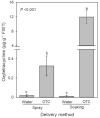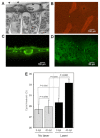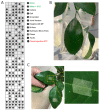Effect of Adjuvants on Oxytetracycline Uptake upon Foliar Application in Citrus
- PMID: 33036241
- PMCID: PMC7599776
- DOI: 10.3390/antibiotics9100677
Effect of Adjuvants on Oxytetracycline Uptake upon Foliar Application in Citrus
Abstract
Recently in Florida, foliar treatments using products with the antibiotics oxytetracyclineand streptomycin have been approved for the treatment of citrus Huanglongbing (HLB), which iscaused by the putative bacterial pathogen 'Candidatus Liberibacter asiaticus'. Herein, we assessedthe levels of oxytetracycline and 'Ca. L. asiaticus' titers in citrus trees upon foliar applications withand without a variety of commercial penetrant adjuvants and upon trunk injection. The level ofoxytetracycline in citrus leaves was measured using an oxytetracycline ELISA kit and 'Ca. L.asiaticus' titer was measured using quantitative PCR. Low levels of oxytetracycline were taken upby citrus leaves after foliar sprays of oxytetracycline in water. Addition of various adjuvants to theoxytetracycline solution showed minimal effects on its uptake by citrus leaves. The level ofoxytetracycline in leaves from trunk-injected trees was higher than those treated with all foliarapplications. The titer of 'Ca. L. asiaticus' in the midrib of leaves from trees receiving oxytetracyclineby foliar application was not affected after four days and thirty days of application, whereas thetiter was significantly reduced in oxytetracycline-injected trees thirty days after treatment.Investigation of citrus leaves using microscopy showed that they are covered by a thick lipidizedcuticle. Perforation of citrus leaf cuticle with a laser significantly increased the uptake ofoxytetracycline, decreasing the titer of 'Ca. L. asiaticus' in citrus leaves upon foliar application.Taken together, our findings indicate that trunk injection is more efficient than foliar spray evenafter the use of adjuvants. Our conclusion could help in setting useful recommendations for theapplication of oxytetracycline in citrus to improve tree health, minimize the amount of appliedantibiotic, reduce environmental exposure, and limit off-target effects.
Keywords: Huanglongbing; adjuvant; citrus; cuticle; foliar spray; laser; oxytetracycline.
Conflict of interest statement
The authors declare no conflict of interest.
Figures





References
-
- Bové J., de Barros A. Huanglongbing: A destructive, newly emerging, century-old disease of citrus. J. Plant Pathol. 2006;88:7–37.
Grants and funding
LinkOut - more resources
Full Text Sources

